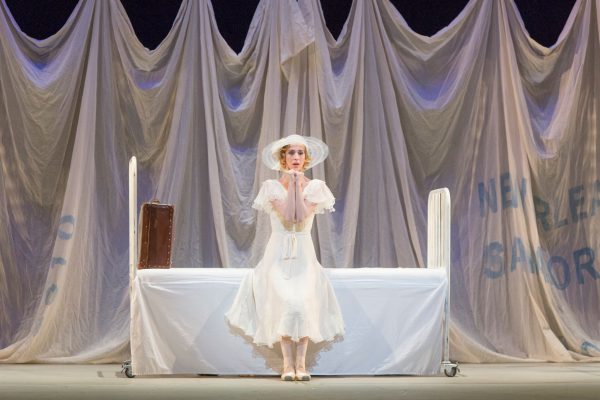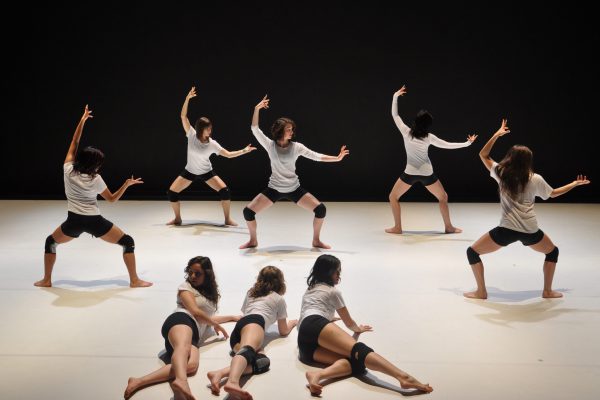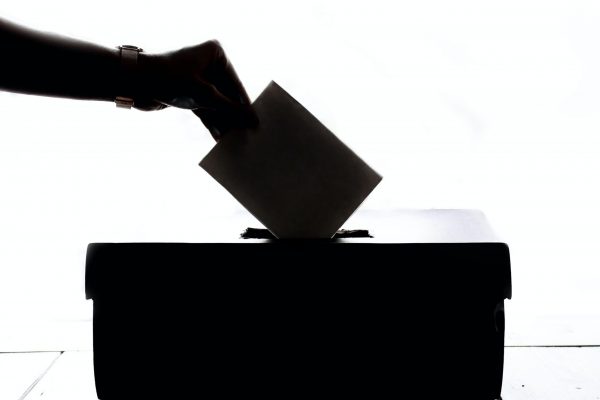A horse, a gorilla, a snake and a fiendish beast; a young girl, a storyteller, a go-go dancer; a teapot, a napkin, and a cast of chairs are all brought together in Susanna Hood’s latest performance, “she’s gone away”, a theatrical dance and sound work that explores female sexual awakening. Throughout the three-year creative process, Hood worked with a stellar list of collaborators including Nilan Perera Katherine Duncanson and Fides Krucker. As a result, the work is distilled so that each movement is the most poignant, each sound the most powerful, each gesture the most evocative. Hood keeps her program notes to a minimum, though she indicates that through her interdisciplinary performing arts company, hum, it is “the territory between sound and movement from which a new sensory language emerges”. The entire evening of “she’s gone away”, from the very foyer of the Theatre Centre to Hood’s multiple curtain calls, is one of transformation — challenging perceptions and expectations. In this, the evening functions as an invitation to open our eyes, ears and especially our minds as we are immersed in this new, multi-sensory language. Choreographer and performer, Hood creates an active and physical entry to her work, involving a series of introductions from viewing Allison Rees-Cumming’s installation of a doll house with films of chaos and uncertainty in each window, to walking the oval perimeter of the Theatre Centre (a changed space in itself as it was once a YMCA: the catwalk I circle was once a running track), then taking the stairs down to find a seat and discovering that the world at the bottom of the stairs is entirely transformed. Through each of these small, but necessary actions, I enter deeper and deeper into work’s psyche, even before the piece begins.
The stage is not the empty or minimalist space common to contemporary dance, but an obscured domestic space brilliantly designed by Lorenzo Savoini. The floor is layered with linoleum tiles and from the tiles, fragments of walls, complete with lamps and wainscotting, rise to support a partial ceiling in the far left hand corner. Though it is full of typical, household accoutrements — a teapot, teacup, napkin, chairs and a lamp — something is awry: the chairs are upended, one perpendicular and suspended mid-wall and the table and lamp have both been knocked over. Familiar and yet disrupted, this domestic scene, as in Rees-Cumming’s work, requires re-examination.
A tipped-over tea party is sipped
from tilted tables and cartwheeling chairs,
Earl Grey and English Breakfast spun dizzy
then forgotten
above chipped floor tiles, like cut-short conversations.
The house lights dim and “she’s gone away” begins with sounds created and engineered by Hood and unseen musician and long-time collaborator Nilan Perera. Gentle breathing slowly changes from an even and measured to a furious and frantic pace. There is something unsettling and even violent about this jagged, razored breath and imperceptible whispering, but it ends as quickly as it began and the light, designed flawlessly by Rebecca Picherak, falls in the right hand corner of the stage, just beyond the set’s walls. Breath is evoked again as Hood plays a single note from a red-patterned concertina. Above the concertina’s harmony, Hood sings in a rich and sonorous tone about a place of sun and sand and sky, a world so different from the broken domestic scene the set provides. This song is yet another prologue to the work, as we are required to engage our imaginations and experience something that is not necessarily what is in front of us.
Inhale, exhale:
a song on the far side of the broken wall, paper,
a wish for sun
above breaths as long as the beach,
as blue as wanting.
Slowly, the song turns agonizingly sexual. Hood’s physicality reflects this change as her naked thighs writhe under her short dress. The concertina breathes, almost heaving, and she sings, “higher and higher and higher” repeatedly, introducing an aural and physicalized sexual experience.
Again, just as it begins, this introduction ends and the light returns to Hood in the centre of the stage. We see an entirely different persona, yet in the same costume (by Heather MacCrimmon) of brown knee socks, brown Oxfords and a brown, button-down-collared, short-sleeved dress, beneath which we still see Hood’s naked thighs. This character is wide-eyed and curious, equine in her upright carriage and long, prancing calves. She proceeds to explore the domestic scene as this horse-like character, seeing the chair, table, fallen-over lamp, teacup and teapot for the first time. We too are able to see these commonplace objects through unknowing, curious eyes, as we also see Hood, the performer, anew, leaving behind the previous singing girl-woman to re-examine this character with our own eyes wide-open.
After startling herself
with the delicate song of cup on saucer,
she drinks the napkin
and chews the tea, cold.
Bone china against shin bone
she sips, again.
The character’s delicate verticality disappears abruptly and is replaced by the scratching, feral presence that began the piece. Any sense of domestication is displaced by Hood’s narrowed eyes, her frenzied breath, her hunched spine. She skirts the edges of the stage as a feverish, wild being, gyrating her hips against the corners of the set. This fiendish presence exists as a representation of repressed sexuality, always present, though marginalized and suppressed.
In keeping with the pattern of appearance and disappearance, this wicked character vanishes and from behind the back wall, a hand reaches along the floor, rolling over itself, weight falling onto its knuckles. Hood re-enters as a gorilla-like character, weight low in her body, eyes dulled above a thick underbite. This transformation is fully embodied, in Hood’s breath and in her physicality.
The third animal Hood assumes is a snake, an apt allusion with explicit references to untamed female sexuality and forbidden, repressed pleasure. As a snake-figure, Hood slithers and undulates along the floor, her amplified voice (she appears to wear a mic in her hair) manipulated to sound like many voices. Sexuality becomes wholly realized as Hood grinds her pelvis into the tiles, back arching in a feral orgasm. Where this explicit, animalistic sexuality has the potential to be unsettling, Hood’s absolute commitment, both physically and aurally, dissuade doubt. She has led us here carefully, with each of the prologues building up layer upon layer of trust and, in keeping with the precedent she has set, this shrieking, clawing creature soon disappears.
The last character Hood invokes is a storytelling human who relates the experience of standing outside her parents’ bedroom as her mother lies with eyes wide open, senses her waiting presence outside and walks towards the doorframe. The story is not defined beyond this suspended moment, but remains imagistically resonant throughout the piece.
She begins a story
and begins
and begins
in the narrow beam of a single light bulb.
She will not finish it, this story,
not yet, not now,
but adds one more word with each telling,
another finger opened from palm.
The animals and story-telling human are abruptly replaced by dance music. The set becomes a discothèque and a bluish light and a follow spot illuminate Hood’s sexy dance-club-inspired moves. She performs for us, smiling teasingly, and lets loose to the thudding rhythm of the bass line. The audience laughs, but the light soon shifts to red and Hood’s movement becomes less hilarious, taking on a darker, more violent sexual intensity. “Come on,” she insists angrily as the music starts to skip. As the score becomes more and more fractured, the aggressive feral creature returns, and the frenzied breath climaxes to a fierce and violent orgasm.
Hood reveals the mastery of her craft as a performer and choreographer as all of her characters begin to conflate. Her command of physicality is astounding as she moves from an equine grace to a gorilla’s dull-witted gravity, to the incessant gyrations of a hyper-sexualized beast to a slithering snake and to a storytelling human. The range of dynamics and movement qualities is tremendous and reveals a powerful journey of self-discovery and revelation. Hood inhabits each of these characters with their varied experiences of sexuality wholly and completely and in embodying each of them, she presents the vast range of experiences that reside in each of us.
After Hood reconstructs the set, lifting up the fallen-over lamp and table and assembling the teapot next to the cup and saucer, the characters are united into a single being and this multi-faceted, singular self repeats, “Come and get me!” She embraces the dark, animalistic corner of sexuality, instead of ignoring and repressing it. In allowing herself to truly experience her own sexuality, violent aggression gives forth to ecstatic pleasure. Unlike the previous shrieking orgasms grinding close to the floor, this orgasm is joyful and experienced standing, with arms outstretched in pure ecstasy.
There is transformation in this work, though the story the human character began is left incomplete, the set is never fully pieced into a domestic scene, and the feral character, while subsumed, is not banished. All of these suspended endings are apt conclusions to an exploration of sexuality and revelation. There are threads that remain untied, fractured as the set’s tiles; however, the final scene is quite staid and proper, with the napkin spread across Hood’s patient, sitting lap, the tea cup filled and delicately sipped. As the tea pot functions as a tea pot, the tea cup as a tea cup, the napkin as a napkin, Hood reinstates a common reality, providing an easily recognizable scene. As she sips her tea, Hood permits us to sit with the weight and reality of her journey, allowing us re-settle back into a world we knew before we saw these household objects through her characters’ curious, and sometimes wild, eyes. And while we experience the domestic world as we may have previously, each object, action and gesture is imbued with the layers of re-examination Hood has inspired. As the light falls on Hood’s multi-sensory world, our eyes, our ears and especially our minds are open and wider than they once were.
Across a lap,
across waiting thighs,
as tea is poured from the pot into a cup,
in a single sentence,
the teaspoon stirs
once, round twice, a third time.
She sips into the afternoon
and then sips again into the evening,
and again, again, it is midnight, gone.
Response to this review
Lindsay:
Thanks for writing such a thoughtful and detailed review. I am pleased to hear your experience of entering deeply into the work, which was my intention. And satisfying as well, to have a poetic reflection mirrored back to me.
I just had one additional point. One thing that has been a bit disappointing to me is the lack of any reference to director Jennifer Tarver in any of the review coverage that the show received (not just here). I think it’s probably in part because of the usual nature of dance that her role has been overlooked, but now that I have an opportunity here to bring this forward, I feel compelled. I cannot say enough about the very essential and significant role that Jennifer played in the last year of development and creation of this work. As I mentioned in my program notes, I went through a number of “outside eyes” through the course of the three years in search of exactly the right person to hold the work with me and to lend their skills to the act of decifering and shaping the intent of the piece. The fact that Jennifer is a seasoned director who is able to work collaboratively with abstract raw material of a number of different disciplines, and who comes from the world of theatre is very significant. These qualities and her intense commitment to the process are what made her the perfect fit. This kind of intense collaboration with another “architect” was a new and important step for me as a creator in this process, and Jennifer’s contribution extended beyond the performance vocabulary to sound and all visual elements. For these reasons, it’s very important to me that people grasp her role in the impact of the work as a whole. I feel very blessed to have had her as such an important collaborator on the work. Thanks.
Susanna Hood
Toronto, ON
Tagged: Contemporary, Performance, ON , Toronto





